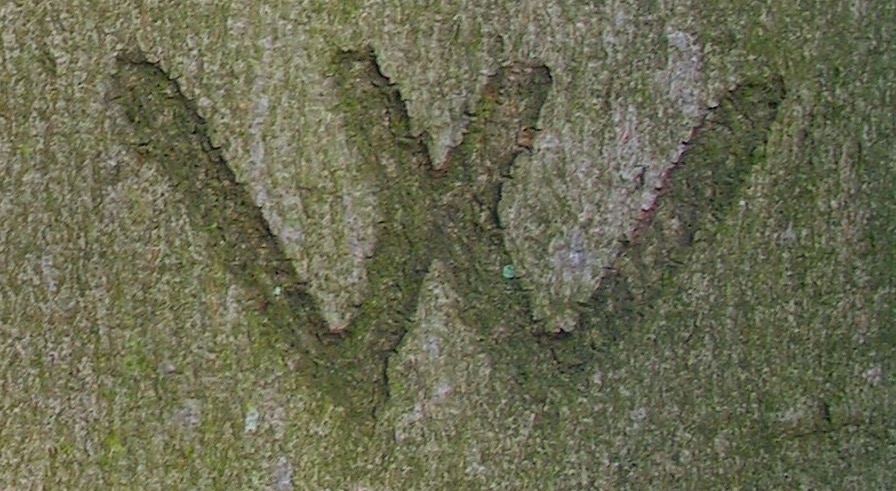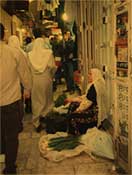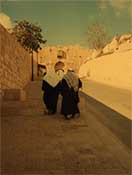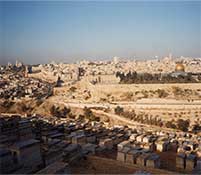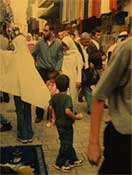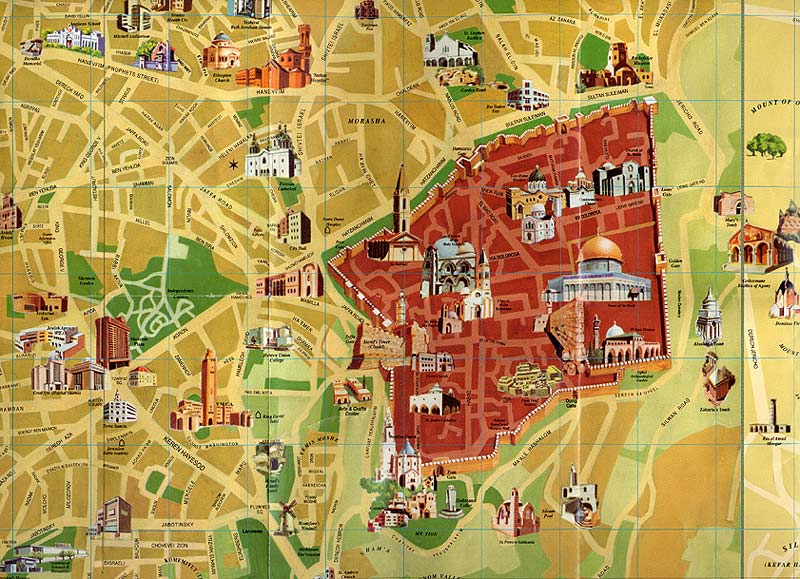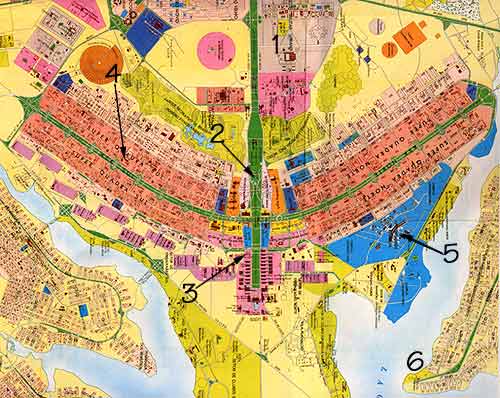Workshops
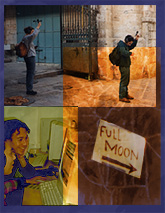
My workshops are essentially an enquiry into our relationship to place through listening and an enquiry into listening itself. Conscious attention to the soundscape is like learning a new language and conscious listening and soundmaking is a way of placing ourselves inside the workings of our cultures, societies and landscapes as involved, living participants.
A variety of listening and soundmaking activities offer ways to deepen our relationship to place and to explore what acoustically balanced sound existences might be. Some workshops may be conducted entirely without the use of technology, others may involve recording equipment, editing and mixing facilities, depending on the context and the focus. Soundwalks may be simple listening walks "by ear" or may also include the use of field recording equipment and/or ear protection. Other activities/actions may involve the creation of sound maps and sound scores, monitoring of and documenting a sound environment in a specific location and for a specific time span, writing of sound journals and many more actions/activities.
Not only is the focus of each workshop slightly different, but also the group of participants may vary greatly. Workshop themes, activities, length and participation are developed according to each context. Topics may range from sound ecology, to listening perception, soundscape composition, the use of music, sound design, noise, radio/media, music, silence, and so on.
My workshops are essentially an enquiry into our relationship to place through listening and an enquiry into listening itself. Conscious attention to the soundscape is like learning a new language and conscious listening and soundmaking is a way of placing ourselves inside the workings of our cultures, societies and landscapes as involved, living participants.
A variety of listening and soundmaking activities offer ways to deepen our relationship to place and to explore what acoustically balanced sound existences might be. Some workshops may be conducted entirely without the use of technology, others may involve recording equipment, editing and mixing facilities, depending on the context and the focus. Soundwalks may be simple listening walks "by ear" or may also include the use of field recording equipment and/or ear protection. Other activities/actions may involve the creation of sound maps and sound scores, monitoring of and documenting a sound environment in a specific location and for a specific time span, writing of sound journals and many more actions/activities.
Not only is the focus of each workshop slightly different, but also the group of participants may vary greatly. Workshop themes, activities, length and participation are developed according to each context. Topics may range from sound ecology, to listening perception, soundscape composition, the use of music, sound design, noise, radio/media, music, silence, and so on.
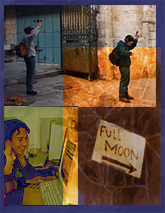
Past workshops
Soundscape Jerusalem
Lecture and workshop on soundscape composition
Jerusalem Academy of Music & Dance, Hebrew University, Givat Ram Campus sponsored by the Goethe Institut, Jerusalem, Israel. Nov 8-19, 1999
The focus of this project was to introduce students to soundscape composition and to the ecological consciousness that is integral to this work and out of which it originally sprang. Listening sessions, recording trips, soundwalks, discussions, editing and mixing of recorded materials were all grounded in the concepts outlined below.
Each sound or soundscape has its own meanings and expressions. It has something to say about us and our society, about our listening and soundmaking habits. As a result, a city like Jerusalem will have a very different soundscape than Vancouver or London or Cape Town.
The portability of sound recording equipment allows us to record any soundscape. The widely available audio technology makes it possible for more people than ever to reproduce these sounds, process them and compose with them. All sounds can become part of a soundscape composition. The activity of "sketching" a city's acoustic image with the use of recorded sounds has fascinated many composers and audio artists around the world for the last ten to twenty years. It has become a new forum for "speaking" about place and environment. Cities like Madrid, Brasilia, Lisbon, Amsterdam, Tokyo, New Delhi and Buenos Aires have been "portrayed" in this way.
If based in a genuine concern for the acoustic environment, these "portraits" expand listeners' horizon towards the soundscape and raise consciousness about its quality. They also may raise questions such as: how do we listen and behave acoustically in everyday life; how can we acquire a "sense of place" and belonging from our soundscapes; are there ways to design liveable soundscapes in our often unliveable urban environments? At the same time they can also offer an artistic interpretation of a city soundscape and present a city as a "sounding" place.
Soundscape Jerusalem threw up interesting questions because of the city's complex historical and political situation. Although relatively peaceful at the time, underlying tensions could always be sensed, particularly by an outsider like me who had never lived in such a politically charged environment. In Old Jerusalem with its four different Quarters (Jewish, Moslem, Christian and Armenian), the different religions and cultures were clearly audible in the soundscape. Churchbells, Muezzins, Armenian Orthodox and Jewish Chants side-by-side could potentially be perceived as dangerous or beautiful sounds, depending on whether they were heard with welcoming or hostile ears.
Within the very short time span of a week, the participating students made a valiant attempt to create a short sound work from the sounds that they recorded in their city. Starting from scratch - learning about soundscape concepts and listening, recording sounds, selecting, editing, processing, mixing - most students managed to come up with a completed short composition. Some students chose to make their recordings in the modern, commercial part of Jerusalem and some chose to participate in the combined listening/recording walk from the Mount of Olives into the Arabic Quarters of Old Jerusalem (see map). Interestingly enough most of the latter students had never set foot into that area of their city. As a result this project posed a double challenge: not only were they exposed to a totally new concept of compositional work, but also they ended up working with recordings from a Jerusalem entirely foreign to them.
The concept of acoustic ecology takes on a specifically cultural, political meaning here. How does the soundscape express the proximity of varying religions, cultures and political histories? Does the soundscape make audible the balances and imbalances that result from this situation? Old Jerusalem in particular is a town of many layers. This is literally visible in its architecture where layer upon built layer has raised today's city several meters above the original ground. The actual desert soil is far away from one's feet and natural vegetation is sparse. At the same time, this same age-old architecture with its narrow alley ways protects inhabitants from motorized traffic. All this is audible in the soundscape: there is an almost complete absence of both natural sounds and traffic noise. Human sounds (from inhabitants and tourists) dominate, footsteps and voices reverberating off stone walls. Music and radio is broadcast from a multitude of shops into the narrow alley ways. And above all, the sounds from churches, mosques and synagogues, send out regular reminders of their all-encompassing religious presence.
Map of Soundwalk
(Click to enlarge.)
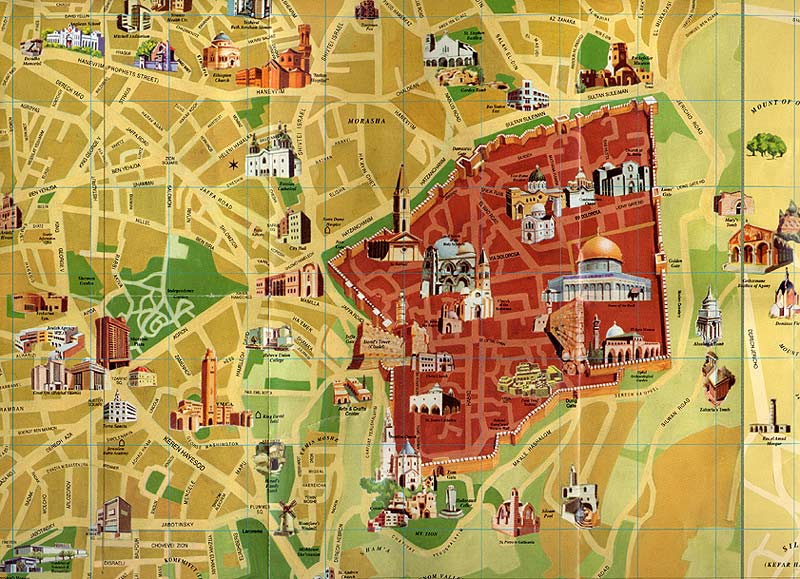
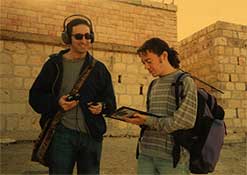
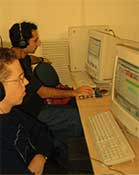
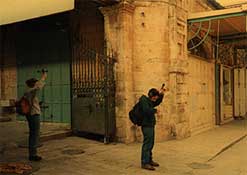
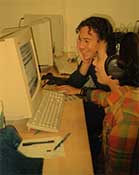
Full Moon Over Killaloe
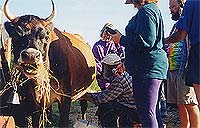
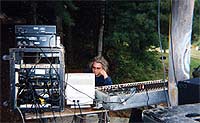
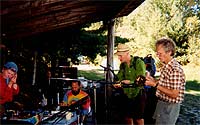
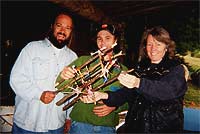
An Audio Art Workshop
August 29 to September 4, 1999.
A Report by Victoria Fenner
originally written for
Soundscape-The Journal of Acoustic Ecology, Vol 1, Number 1, p. 30
In a noisy world, there are few opportunities for audio artists to listen and create without external distractions. There are even fewer opportunities to get together with other artists to listen and create together. Full Moon Over Killaloe was a rare opportunity to do both. It was held near Killaloe, Ontario, a Canadian village about two hours car drive west of Ottawa.
The purpose of Full Moon was to explore new directions in audio artwork and stimulate production. Through workshops, audio art concerts, group feedback and independent creative time, the participating artists developed and shared new ideas with each other and with our two artists-in-residence, Hildegard Westerkamp and Michael Waterman.
It was held at the Killaloe Fairgrounds, a rustic camping facility in the heart of the Madawaska Valley about two kilometers outside of the village. The experience of living without walls created an artistic edge that could not be replicated in an urban environment. The campgrounds are located in the bottom of a small valley, creating a sense of isolation from the outside world. The hills on all sides create an unusual and interesting acoustic space. Our production studio was a minimal wooden stage, built at the bottom of a hill. Our gear consisted of three computer editing stations, sound boards, lots of speakers and recording equipment. Each participant also brought their own microphones and portable recording gear, which made for an interesting show and tell. I counted at least twelve different kinds of microphones, including a shock mount for a Sennheiser shotgun mike created from sticks picked up in the forest. A striking contrast between high tech and no tech.
The studio was in constant use. Sounds from the studio (which was also used as a stage) reverberated up the hill, creating interesting recording possibilities for listening, recording and performing. It was also far enough from the nearest neighbour that we were able to work late into the night without disturbing anyone (except the cows in the next field, who were very confused when we played a recording of cows from another farm bellowing to be milked. Even more confusing, these were morning recordings of cows).
Some of the participants suggested that living in minimal surroundings forced them to face their artistic experience head-on. We heard no sound other than the natural ones around us and those we created ourselves. No radio, no internet, no media of any kind, no visitors, except for two scheduled public concerts. The challenge to create was present 24 hours a day for all seven days. We worked hard, rising with the sun and falling back to sleep long after the moon had risen.
Highlights of the week included a two hour soundmaking session in nearby Bonnechere Caves, where no less than four performances happened simultaneously (with interesting echoes and reverbaration). Jam sessions were held each night, consisting of sounds made from found objects and recorded sounds from earlier in the day. We began each morning with a soundwalk where we listened, shouted to the hills and created sounds from trees, rocks, leaves and our own footsteps. Impromptu rehearsals of new pieces were held under trees, at the beach, over dinner, around the campfire, set to a constant soundtrack of late August crickets in Ontario.
The value of the experience is summed up by workshop participant Scott Stevens, an artist from Kingston, Ontario.
"The experience was exceptional. It brought together people from every level of technical and artistic experience, and a full range of ideas and concepts. Over the week I couldn't help but be influenced and inspired by the diverse range of work that was presented or being explored. ... I find it exciting to meet the people with whose work I am somewhat familiar and thus have the chance to bring to light the specific thoughts and techniques behind the artists' work. Hildegard Westerkamp certainly made much more clear to me what can go into the making of a soundscape/electroacoustic piece, with the dissection of one of her compositions(Sensitive Chaos). She introduced us to soundwalks as well, which encouraged me to develop more alertness towards all the sound around me. The other participants were also contributing to my awareness of sound and the making of audio art."
Full Moon over Killaloe has become an annual event and has been lead by different artists-in-residence each year, most recently by Andra McCartney and Darren Copeland.
Earwitness: A Tale of Cities
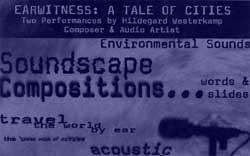
a Sound Adventure Project
Seattle Art Museum and Goethe Institut, Seattle
March 8-10, 1996
This combination of workshop and lectures was meant as an introduction to the world of soundscapes and listening with the specific purpose to connect this to the learning of foreign languages and the exposure to new cultures. It was a way to introduce language students both to the acoustic environment and to a new language through readings and exercises which combine scientific and creative inquiry into the nature of sound. "Regarding the foreign language classroom, this project will foster cross-curriculum instruction and communicative approach in foreign language teaching. The additional goals include the development of listening skills, extension of vocabulary, creative writing, cultural exchange and mutual understanding, and the applicaiton of email technology." (from Goethe Institut Seattle project proposal)
The workshop included soundwalks, listening exercises, discussions and reflections on acoustic ecology and the meanings of sounds/soundscapes, as well as the writing of sound journals. The second part of the workshop consisted of a brain storming session of how to apply soundscape awareness and listening to foreign language instruction and the development of concrete lesson plans. In the months following, a curriculum was developed for classroom use.
The two lectures functioned as a general introduction to the world of sound and specifically dealt with urban soundscapes. Although environmental sounds can give us a sense of place and belonging, urban noise has the power to obscure this sense. Two lecture-performances suggested ways of listening beyond the noise, to uncover by ear a city's acoustic indentity, its inner voice, that which makes Seattle sound different than New Delhi, Tokyo different than Brasilia.
Unfortunately the Seattle Goethe Institut (among several other Goethe Instituts in other countries) was closed in 1999 as part of major financial cuts by the German Government.
Soundscape Brasilia
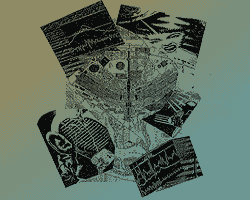
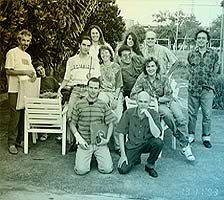
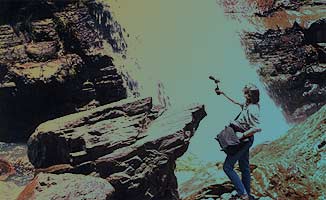
Sponsored and hosted by the Goethe Institut Brasilia, Brazil
Artistic Direction: Hildegard Westerkamp
Technical Production and Consultation:
Michael Fahres and Piet Hein van da Poel
November 5-11, 1993 and April 20 - May 22, 1994
This workshop's emphasis was high-tech and production oriented. The aim was to produce a number of compositions about Brasilia's soundscape, composed by a group of people from Brasilia. It was an ambitious project and would not have been possible to realize without Michael Fahres and Piet Hein van de Poel from Netherlands Broadcasting Corporation who were the co-producers of the project and brought the necessary technology and skills. They were instrumental in assisting with the successful completion of seven soundscape compositions, which then were presented in an outdoor concert and later compiled on a CD.
Soundscape Brasilia was unusual in the sense that we had more time than in any other context for the whole process. It ranged from a first week-long meeting in which concepts of soundscape and acoustic ecology were introduced, and participants were led through listening and sound recording experiences; to 5 months of gathering and cataloguing of sound materials by participants, as well as preliminary planning for the pieces; to 4 weeks of composing, all of it culminating in a weekend seminar with lectures, soundwalks and a concert presenting the participants' compositions.
Most participants had some musical background, but it varied from rock to classical to folk. A few had experience with the radio medium and thus were familiar with sound production to a certain extent. Two were architect students and had no background in music or radio at all. None of the participants had ever composed with environmental sounds and some had never composed at all. This made the compositional part of the process particularly interesting as we addressed the main questions of the project: "How do we speak about this city through its own sounds?" "What is there to say that is relevant and how do I say it?" At every stage, discussions about the content of the work and its structures were part of the ongoing process.
Some pieces were produced collaboratively by two or three people, some were composed by one person alone. Each of them reflect in some way the composers' particular and characteristic perspective and speak about that which interests or fascinates them most in this city, using the sounds that assist in this expression. All of them reveal clearly a relationship between composer and place - the place of Brasilia.
Sound Excursion: Plano Pilato, Brasilia
We decided to do a sound excursion by car rather than a soundwalk, because Brasilia was designed for the car, not for pedestrians. A one-hour long soundwalk, would have given us very little acoustic variety, as it is hard to get away from traffic noise.
The part that looks like a bird or an airplane on the map, is the so-called Plano Piloto, pilot plan, designed by Lucio Costa. The body of the "airplane" is made up of the Monumental Axis - Eixo Monumental - along which we find most government institutions, the cathedral, the hospital, commercial, hotel and bank sectors, the TV tower, the military sector and the overland bus and train station. The wings of the airplane, called Asa Sul and Asa Norte, are made up of the Residential Highway Axis which moves from North to South. This is where most people live in three to six story apartment buildings. Where the two axes meet is the rodoviaria, the central bus station. This, ironically, is the centre of Plano Piloto, a far cry from plazas, market places, piazzas - the "Commons" of many city centres of the world. It is the noisiest place of Brasilia, where the work force from the satellite cities arrives and departs every day.
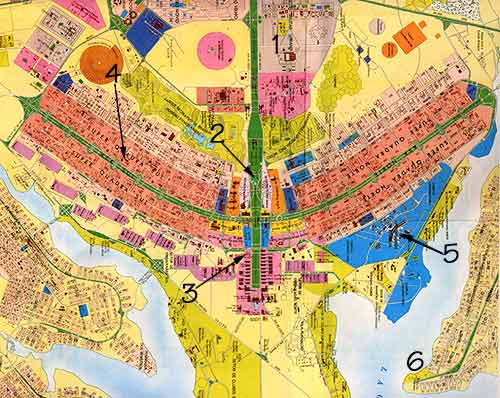
Map of Soundwalk
(Click to enlarge.)
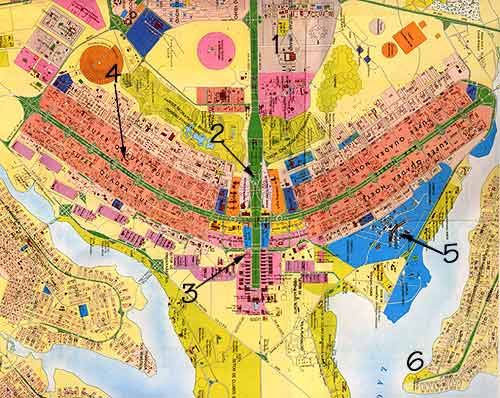
Instructions to Excursion Participants
The map shows six different listening points of interest. Some of these are places where workshop participants have made sound recordings for their compositions.
You will be given ear plugs for this excursion. Please, wear them every time you travel in the car and take them out as soon as we have arrived at a listening point of interest. You will hear a sound signal when it is time to return to the car.
NOTE: The focus is listening: Please, refrain from talking throughout the duration of this excursion unless of course, there was an emergency.
1. Military Sector: Listen to the relative quiet here after car travel; flagpoles like chimes in the wind; the "concha acoustica", a place for soundmaking: listen to your sounds as they are bounced around by this architectural structure.
2. Market under television tower: This is a weekend market. Spend 20 minutes here. Let the sounds and your curious ear determine your route through the market. At the end let your ears be drawn to the fountain just east of the market to meet the group.
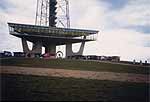
3. Cathedral: Here we will split into two groups for the exploration of the whisper gallery. In order to get the full acoustic effect to the whisper gallery, talking, whispering or some kind of soundmaking is required. The aim is to communicate with the other person on the opposite side of the cathedral. You may have to move aound a bit to find the optimum spot. You can discuss secrets. No one else in the cathedral will be able to hear you. What other sounds do you hear? [At this point in the sound excursion one of the workshop participants showed us a round ceremonial space in another part of the cathedral building. As soon as we entered it we spontaneously started to chant long tones. I am convinced that it was the acoustic and visual design of this room that had generated this reaction. We stayed for at least 30 more minutes. No one minded this unplanned delay. Quite the opposite, it heightened our awareness of the soundscape and created new energy for the remainder of the excursion.]

4. Superquadra: This is one of the many designed residential areas in Plano Pilato. Take 20 minutes to explore its soundscape (see map). if you don't want to walk, there are plenty of shady places to sit and listen. What sounds emanate from the apartment blocks? From the lawns, tress and bushes? Think back to your own home and compare soundscapes. Listen to the signal. Meeting place is at the small church.

5. University: Explore the sounds of architectural structures and sculptures.
6. Lake Shore: Spend 10 minutes listening. Bamboo in the wind. Water. Birds, People. The signal will announce the official end of the sound excursion.
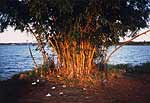
Brasilia Soundscape Compositions
The CD is no longer available. However, the programme notes presented below from each of the compositions will give a sense of Brasilia's soundscape and the composers' relationship to their home town. (Sound excerpts to be added soon.)
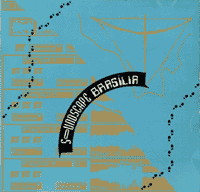
Ressonância
by Juliane Berber and Christian M. Bassay Blum
Sound Excerpt 1 (1:00)
Sound Excerpt 2 (0:50)
The composers were architect students at the time of the workshop. And it is perhaps not surprising that the piece moves through various spaces of resonance, from an abstract sonic space to nature, to human/urban work and habitation back into abstract space. What I call abstract space is created by a sonically very rich sound with which the piece begins: the resonant frequencies of a metal pipe, found by placing the microphone inside the pipe. A rhythmical sound abstracted from an industrial source brings movement into the resonance and takes us to the very contrasting sounds of crickets.
The second example takes us into a very interesting acoustic space in the city: that of the cathedral. Visually this cathedral is a striking piece of architecture. Acoustically only its reverberation and its whisper gallery effect are reminiscent of cathedral design. The beauty and effectiveness of these acoustic qualities, however, is highly reduced by the invading traffic noise of the nearby roads. It seems that no attempt has been made to create what is characteristic for a church or a cathedral: a sanctuary, where quiet worship and meditation is possible. In this recording the police sirens penetrate the cathedral's transparent walls easily and sound almost attractive as they are transformed by the reverberant environment. An additional sound of a single repetitive waterdrop heightens the sense of unreality of this place.
D-Ambulante
by Celso Araújo, Marcelo Araújo, João Cláudio Silveira
Excerpt (1:45)
All three composers worked in radio. Structurally the piece is a montage. The voice is its main sound source, the voice in various walks of life, on the street, in the media, singing voice, speaking voice, children's voices, etc. It is a piece of social commentary about Brasilia, contrasting in a poetic way the political and private, sacred and profane, solitary and collective, media voice and street voices. Many of the voices will be immediately recognizable to local people. In this excerpt you'll hear the voices of a theatrical performance, media voices, street musicians, the voice of an Indian, and so on.
Dreamwalk
by Claudio Vinícius and Bené Fonteles
Excerpt (2:10)
Both composers lived in the country side just outside of Brasilia and were actively engaged in ecological issues. This is a slow-moving, indeed dreamlike piece. It is in the selection of sounds, their juxtaposition and processing that the dreamlike quality of the piece emerges. Simple processing such as slowing down of the animal sounds, creates an unusual effect, immediately striking and appealing. It is perhaps not surprising that this piece comes from two people who spend a great deal of time in the countryside and wilderness. As I hear it, the piece wants to reach more deeply into our psyche, into our perception of the soundscape, in an attempt to understand and experience its deeper meanings.
Exomapascape
by Fernando Corbal
Excerpt 1 (0:40)
Excerpt 2 (0:21)
Excerpt 3 (0:39)
Fernando was a musician and performer. He composed this piece with the explicit purpose to preserve the realism of the soundscape. It is a short and effective journey through the day of a middle class person in Brasilia. Leaving the quiet of the home, through the sound of a metal gate, entering the car, the work world with all its hectic, intense rhythms, finding recreation and stimulation later on the playground and in the gym with children, and finally ending up in the calming soundscape of a natural environment.
The first example is the beginning of the piece with its fast movement from home to work. Note the wonderful squeaks of the metal gate.
The second example is an exploration of another metal squeak, swings on the playground. You'll hear three swings together and then a slowed down swing sound is faded under, which makes the squeaks all the more attractive. Metal squeaks seem to be a very typical sound in this part of the world: a lot of unoiled hinges and a lot of metal chairs scraping on tiled floors.
The third example I find particularly attractive in the way Fernando compositionally leaves the bustling noisy urban day and returns to a quiet natural soundscape. Note how he uses the turning off of a jet engine to underline this effect.
Brasil - ia
by Damian Keller
Excerpt (1:33)
Damian was a music student at the university in Brasilia at the time and has since come to North America to pursue his compositional studies further (http://www-ccrma/~dkeller and http://www.sfu.ca/~dkeller). His piece is more abstract in nature than the other compositions in this context and is perhaps closest to the genre of a contemporary electroacoustic composition. He created his sound materials by hitting various architectural structures as if they were musical instruments: metal support columns of buildings at the university and metal sculptures. He hit them with his hands and a variety of other devices and recorded the sounds. These then were processed and mixed on the computer. The result is a piece of sonic architecture, almost an aural equivalent to the monumental aspects of Brasilia's architecture.
Brass Ilha (Brass Island)
by Ernesto Donas Goldstein, Juán Carlos Arango, Luís Francisco Latorraca
Excerpt 1 (1:14)
Excerpt 2 (0:38)
All three composers were music students at the university in Brasilia. Like Damian they limited their materials to a few sounds, but combined them with synthetically constructed instrumental sounds. The piece explores the boundaries between musical instruments and environmental sounds: environmental sounds are used as if they were musical instruments and instruments as if they were environmental sounds. This piece has a delicate, transparent quality and is sensitively constructed in its interaction between musical/instrumental sounds and the recorded sounds. It is a slow moving piece and has the courage to spend time in quiet soundscapes and to explore sonic details.
The first example simply shows the delicate interplay between waterdrops and instruments.
In the second example the main sound is that of a particularly squeaky water fawcett found in a men's washroom and played like a musical instrument. I have heard similar sounding improvisations on the saxophone.
Planos
by Luis Roberto Pinheiro
Excerpt (1:50)
This piece is an intricately composed montage of many small snippets of sound alternating with longer sections of total sound events. It has been constructed around certain rhythmical structures, partially determined by the sound materials themselves, partially imposed onto the sounds as a structural element. The piece moves very quickly through a lot of sound materials. It is a powerful sonic statement of sonic planning. Planos attempts to unite the incidental, chaotic sounds of everyday life inside the artistic microcosm of a musical structure.
More Workshops
Das Komponierende Ohr
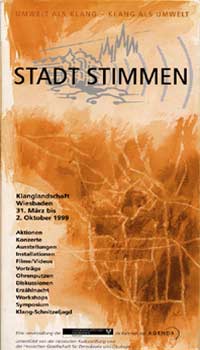
Soundscape Workshop at Stadtstimmen, Wiesbaden, Germany June 18-19, 1999
Das Ohr hört immer zu und begleitet uns durch den Alltag. Diesem klanglichen Zeitablauf tägliche Aufmersamkeit zu schenken, ändert die Qualität unseres Zuhörens und unseres Zeiterlebens. Es kann bedeuten, der Alltagshast entgegenzutreten, und ihr still zuzuhören, oder Klänge in der Stille verfliessen zu lassen, sie in uns zur Ruhe zu bringen und widerhallen zu lassen. Die Qualität unseres Zuhörens kann die Qualität eines klanglichen Zeitablaufes (eines Gespräches, eines Musikstücks, ja sogar die Qualität einer Klangumwelt) beeinflussen und ändern. Dieser Workshop versucht durch verschiedenartige Hörerlebnisse und aktivitäten konkrete Erfahrung mit dem "komponierenden" Ohr zu vermitteln.
Soundscape Delhi, Oct. 97, Oct. 94, Nov. 92
One to four-week soundscape workshops and lectures hosted and sponsored by Max Mueller Bhavan, Delhi (branch of the German Goethe Institut), India.
Stille und Schall

Soundscape Workshop at Ganz Ohr (All Ear), sponsored by Hessischer Rundfunk, Kassel, Germany Sept 24-27, 1997
Zuhören und Klangmachen entsprechen einander wie Einatmen und Ausatmen. Im Still-sein-Können wird die Qualität unseres Zuhörens geboren; vom Zuhören-Können wird die Qualität unseres Klangmachens geprägt. Dieses sensible Gleichgewicht soll mit Ohr und Stimme, Mikrophon und Lautsprecher erkundet werden.
Soundscape Vancouver '96, May/June 1996
Co-ordination of workshop, lecture/symposium and concert, in collaboration with the Goethe Institut Vancouver, Sonic Studio, Simon Fraser University, Vancouver New Music, Canadian Broadcasting Corporation.
Inside the Soundscape-Im Innern der Klangumwelt
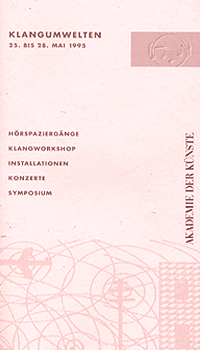
Soundscape Workshop at KlangUmwelten, Akademie der Künste, Berlin, Germany May 25-28, 1995
Die Workshops geben Gelegenheit zu einer Reise in die Welt der individuellen akustischen Imagination. Ich möchte mit den Teilnehmern und Teilnehmerinnen das erforschen, was ich während meines eigenen kompositorischen Prozesses erfahre: die feine Linie zwischen konkreten Umweltklängen und der Art und Weise wie der Hörer sie erlebt.-Während unserer Reise ins Innere der Klangumwelt lauschen wir den Klängen des Workshop-Raums nach, den Aussengeräuschen und unserer eigenen Stimme, beobachten unsere Wahrnehmung, wenn wir Ohrenpfropfen benutzen, hören uns in den Klang fremder Landschaften hinein und wenden uns schliesslich bearbeiteten Klängen ("processed sounds") zu.-Die Sitzungen haben jeden Tag ein anderes Thema (z.B. Stadt, Wildnis, Stimmen, Medien). Was aber stets ähnlich sein wird, ist das Fortschreiten von der konkreten Klangumwelt zur akustischen Imagination und zur Komposition. Die Workshops sollen nicht nur zum besseren und genaueren Hären anregen, sondern den Einzelnen dazu inspirieren, sich selbst durch Klang bewusster und individueller auszudrücken.
From Bauhaus to Soundscape: Sound Ecology-New Horizons in Design Oct. 5-9, 94
Workshop and Lectures sponsored by the Goethe Institut Tokyo, Japan.
read lecture
